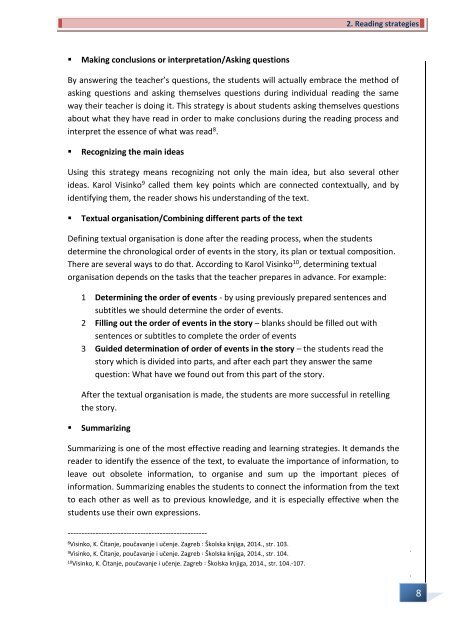THE BRIDGE-HELPFUL READING LITERACY STRATEGIES
You also want an ePaper? Increase the reach of your titles
YUMPU automatically turns print PDFs into web optimized ePapers that Google loves.
2. Reading strategies<br />
• Making conclusions or interpretation/Asking questions<br />
By answering the teacher’s questions, the students will actually embrace the method of<br />
asking questions and asking themselves questions during individual reading the same<br />
way their teacher is doing it. This strategy is about students asking themselves questions<br />
about what they have read in order to make conclusions during the reading process and<br />
interpret the essence of what was read 8 .<br />
• Recognizing the main ideas<br />
Using this strategy means recognizing not only the main idea, but also several other<br />
ideas. Karol Visinko 9 called them key points which are connected contextually, and by<br />
identifying them, the reader shows his understanding of the text.<br />
• Textual organisation/Combining different parts of the text<br />
Defining textual organisation is done after the reading process, when the students<br />
determine the chronological order of events in the story, its plan or textual composition.<br />
There are several ways to do that. According to Karol Visinko 10 , determining textual<br />
organisation depends on the tasks that the teacher prepares in advance. For example:<br />
1 Determining the order of events - by using previously prepared sentences and<br />
subtitles we should determine the order of events.<br />
2 Filling out the order of events in the story – blanks should be filled out with<br />
sentences or subtitles to complete the order of events<br />
3 Guided determination of order of events in the story – the students read the<br />
story which is divided into parts, and after each part they answer the same<br />
question: What have we found out from this part of the story.<br />
After the textual organisation is made, the students are more successful in retelling<br />
the story.<br />
• Summarizing<br />
Summarizing is one of the most effective reading and learning strategies. It demands the<br />
reader to identify the essence of the text, to evaluate the importance of information, to<br />
leave out obsolete information, to organise and sum up the important pieces of<br />
information. Summarizing enables the students to connect the information from the text<br />
to each other as well as to previous knowledge, and it is especially effective when the<br />
students use their own expressions.<br />
--------------------------------------------------<br />
8<br />
Visinko, K. Čitanje, poučavanje i učenje. Zagreb ꞉ Školska knjiga, 2014., str. 103.<br />
9<br />
Visinko, K. Čitanje, poučavanje i učenje. Zagreb ꞉ Školska knjiga, 2014., str. 104.<br />
10<br />
Visinko, K. Čitanje, poučavanje i učenje. Zagreb ꞉ Školska knjiga, 2014., str. 104.-107.<br />
[datum]<br />
8


